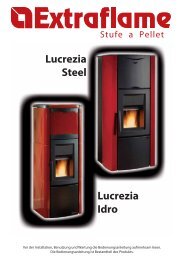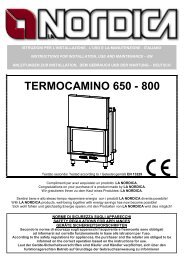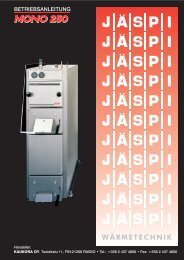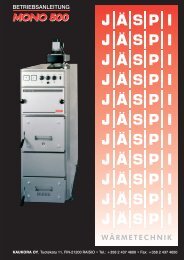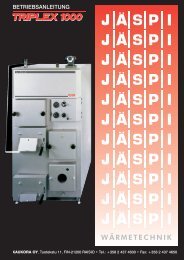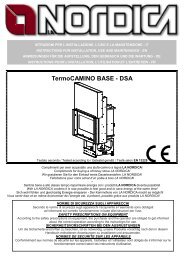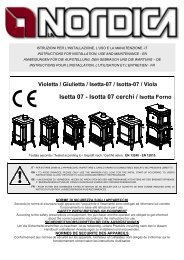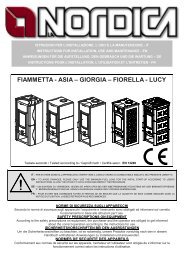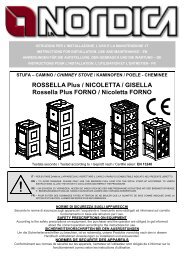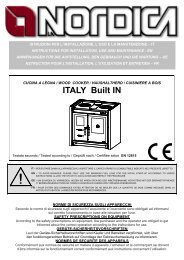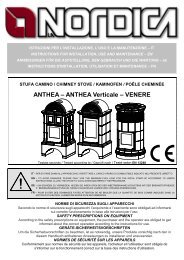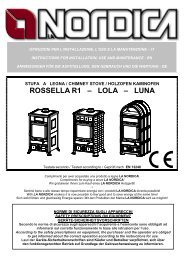giada
giada
giada
Create successful ePaper yourself
Turn your PDF publications into a flip-book with our unique Google optimized e-Paper software.
GIADA<br />
5. FLUE<br />
Essential requirements for a correct operation of the appliance:<br />
• the internal section must be preferably circular;<br />
• be thermally insulated and water-proof and produced with materials suitable to resist to heat, combustion<br />
products and possible condensates;<br />
• not be throttled and show a vertical arrangement with deviations not greater than 45°;<br />
• if already used, it must be clean;<br />
• observe the technical data of the instructions manual;<br />
Should the flues have a square or rectangular section, internal edges must be rounded with a radius not lower than 20<br />
mm. For the rectangular section, the maximum ratio between the sides must be ≤ 1.5.<br />
(1) (2)<br />
(3)<br />
(4)<br />
A+1/2A<br />
Max.<br />
A+1/2A<br />
A<br />
(1) AISI 316 steel flue with double chamber insulated with material resistant to 400°C. Efficiency<br />
100% excellent.<br />
(2) Refractory flue with insulated double chamber and external coating in lightweight concrete.<br />
Efficiency 100% excellent.<br />
(3) Traditional clay flue showing a square section with cavities. Efficiency 80% excellent.<br />
(4) Avoid flues with rectangular internal section whose ratio differs from the drawing.<br />
Efficiency 40% poor.<br />
Picture 3<br />
A too small section causes a decrease of the draught. It is suggested a minimum height of 4 m.<br />
The following features are forbidden and therefore they endanger the good operation of the appliance: asbestos<br />
cement, galvanized steel, rough and porous internal surfaces. Picture 3 gives some examples of execution.<br />
The minimum section must be 4 dm 2 (for example 20 x 20 cm) for appliances whose duct diameter is lower<br />
than 200 mm, or 6.25 dm 2 (for example 25 x 25 cm) for appliances with diameter greater than 200 mm.<br />
The draught created by the flue must be sufficient, but not excessive.<br />
A too big flue section can feature a too big volume to be heated and consequently cause difficulties in the operation of<br />
the appliance; to avoid this, tube the flue along its whole height. A too small section causes a decrease of the draught.<br />
The flue must be properly spaced from any flammable materials or fuels through a proper insulation or an air<br />
cavity.<br />
It is forbidden to let plant piping or air feeding channels pass in the same flue. Moreover, it is forbidden to create<br />
movable or fixed openings on the same for the connection of further other appliances.<br />
5.1. CHIMNEY CAP<br />
The draught of the flue depends also on the suitability of the chimney cap.<br />
Therefore, if it is handicraft constructed, the output section must be more than twice as big as the internal section of<br />
the flue.<br />
Should it be necessary to exceed the ridge of the roof, the chimney cap must assure the discharge also in case of<br />
windy weather (Picture 4).<br />
The chimney cap must meet the following requirements:<br />
• have internal section equivalent to that of the stack.<br />
• have a useful output section twice as big as the flue internal one.<br />
• be manufactured in such a way as to prevent the penetration of rain, snow, and any other foreign body in the flue.<br />
• be easily checkable, for any possible maintenance and cleaning operation.<br />
(1) Industrial chimney cap<br />
with pre-fabricated<br />
elements – it allows an<br />
excellent discharge of the<br />
smokes.<br />
(2) Handicraft chimney cap.<br />
The right output section must<br />
be at least twice as big as the<br />
internal section of the flue<br />
(ideal value: 2.5 times).<br />
(3) Chimney cap for steel<br />
flue with internal cone<br />
deflector of smokes.<br />
Picture 4<br />
7196001 Rev.05 – EN 19



